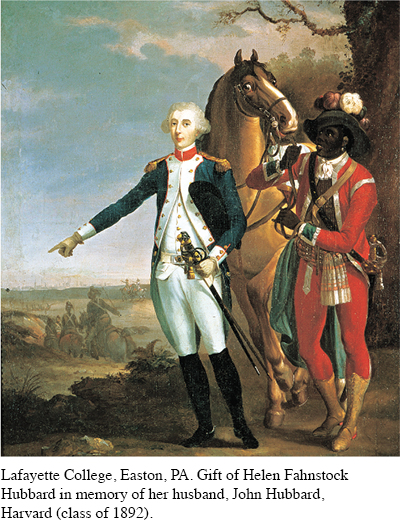The American Promise: Printed Page 191
The American Promise, Value Edition: Printed Page 177
The American Promise: A Concise History: Printed Page 201
The Losers and the Winners
The surrender at Yorktown spelled the end for the British, but two more years of skirmishes ensued. Frontier areas in Kentucky, Ohio, and Illinois blazed with battles pitting Americans against various Indian tribes. The British army still occupied three coastal cities, including New York, and in response, an augmented Continental army stayed at the ready, north of New York City. Occasional clashes occurred, like the ones in which Deborah Sampson saw action while cross-

The Treaty of Paris, also called the Peace of Paris, was two years in the making. (See “Beyond America’s Borders: European Nations and the Peace of Paris, 1783.”) Commissioners from America and Britain worked out the ten articles of peace, while a side treaty signed by Britain, France, Spain, and the Netherlands sealed related deals. The first article went to the heart of the matter: “His Britannic Majesty acknowledges the said United States to be free Sovereign and independent States.” Other articles set the western boundary at the Mississippi River and guaranteed that creditors on both sides would be paid in sterling money, a provision important to British merchants. Britain agreed to withdraw its troops quickly, but more than a decade later this promise still had not been fully kept. Another agreement prohibited the British from “carrying away any Negroes or other property of the American inhabitants.” The treaty was signed on September 3, 1783.
News of the treaty signing was cause for celebration among most Americans, but not among the thousands of self-
The emancipation of slaves had never been a war goal of the British; destabilizing patriot planters and gaining manpower were their initial reasons for promises of freedom. Had the British won the war, they might well have reenslaved insurgent blacks to restore the profitable plantation economy of the South. For their part, blacks viewed British army camps as sites of refuge (not figuring on the devastations of epidemic diseases and food shortages) and had no reason to revere the British monarchy. In fact, some runaways had headed for Indian country instead.
The Treaty of Paris had nothing to say about the Indian participants in the Revolutionary War. As one American told the Shawnee people, “Your Fathers the English have made Peace with us for themselves, but forgot you their Children, who Fought with them, and neglected you like Bastards.” Indian lands were assigned to the victors as though they were uninhabited. Some Indian refugees fled west into present-
With the treaty finally signed, the British began their evacuation of New York, Charleston, and Savannah, a process complicated by the sheer numbers involved—
REVIEW Why did the British southern strategy ultimately fail?